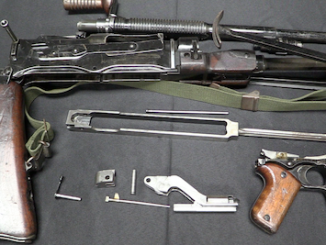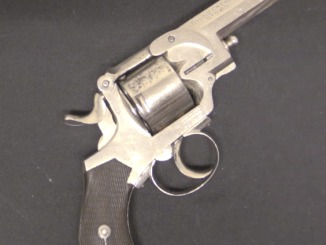Wall guns are the philosophical predecessor to today’s anti-material rifles – large-caliber, high power rifles heavy enough that they cannot be fired from the shoulder realistically. Traditionally, they were used for defending walls or ramparts, as the name implies. They would allow defenders to perforate armor that would be proof against normal shoulder rifles, and also have a more substantial ballistic impact at long ranges than a normal rifle.
This particular one was made in Belgium in 1862, and is a .75 caliber breechloading design with a percussion ignition and hexagonal Whitworth-type rifling.




Thanks for the proper video! I’d seen the recent blog post from RIA themselves, and I wondered if this was among the items you would inspect with a video. A must-have sort of conversation piece, and if it goes higher in bidding than I can afford, at least I can make a close replica thanks to your video!
The structure is strongly reminiscent of the “swivel guns” used on warships in the 15th through early 17th Centuries, which had multiple breech “canisters” rather like iron beer steins to allow rapid fire. Loaded with shot instead of a single ball, they were very good at sweeping an enemy’s deck to maim and kill his gun crews- or fired down into the main deck of your own ship from the aftercastle, were equally effective at putting paid to a fo’c’sle mutiny.
Field guns on the same principle were common until corned powder became the standard artillery propellant around 1570-1600 AD. They didn’t stand up well to the greater pressures, and erosion of the male/female joint with the barrel accelerated. Charles the Bold of Burgundy (1433-77; r. 1467-77) used such pieces in his artillery train.
cheers
eon
I suppose this what you describe is close to falconet – light gun of 16.century.
https://en.wikipedia.org/wiki/Falconet_(cannon)
I can see further miniaturised version of it in the showcased gun. I suspect it was used on select targets at long range fire (see rear sight), primarily against crews of bigger guns. The hexagonal bore was apparently more “merciful” version of square bores (such as Puckle gun in London’s Tower has).
The falconet was the lightest gun in Henry II of France’s inventory of six types; from largest to smallest they were Cannon, Great Culverin, Bastard Culverin, “Legitimate” Culverin, Falcon, and Falconet. Most people forget that back then, a “cannon” was a gun of a specific bore size, length, tube weight, and charge and shot load, rather than just a generic term for big guns in general.
The swivels were often called serpentines, due to being small and nasty, and often having a long, slender “tiller” rather like a snake’s tail for swinging them around. They came in both muzzle-loading and breech-loading persuasions; the muzzle-loaders were around much longer than the breechloaders in European navies, but the latter were common in Asia and other less-developed areas until relatively recently;
https://en.wikipedia.org/wiki/Breech-loading_swivel_gun
“Serpentine” later became a term for either a heavy matchlock arquebus fired from a yoke on a ship’s rail, or else a matchlock rifle with a spare shot barrel that could be “swapped in” when needed.
Swivel guns survived well into the 19th Century as naval armament, ranging from large-bore muskets to what might be better termed “boat guns”. They were used by all sides’ navies during the Napoleonic Wars, and some navies (such as ours) retained them for light-boat and “riverine” duties well into the percussion era;
http://3.bp.blogspot.com/-ebijlPp3pI4/UYj1X0RYg1I/AAAAAAAAARI/FoSHrzCbF3w/s640/Blog+3-2.jpg
You still find them in remote areas, and they had “relatives”, too, such as the lela and lantaka in the Far East;
https://en.wikipedia.org/wiki/Lantaka
cheers
eon
Seems like you could have a supply of extra breech blocks and have a crew reloading them so you could have a pretty high rate of sustained fire.
They were probably mainly meant for sniping at enemy besieging lines around a fortress, especially at artillery positions or enemy snipers or observers. The large size would have been for long range rather than penetration. As such they were probably more comparable to today’s .338 Lapua Magnum sniper rifles than anti-materiel rifles.
There wasn’t really much in the way of resistive “materiel” in those days to shoot at. It was all men and horses. If you look at Crimean war photos however, you will see lots of Russian guns (artillery) which were equipped with mantlets (shields) to protect the gunners from British and French snipers.
Exactly, that’s what I thought: an early anti-material rifle.
Should have rather said “anti-sniper” and select importance ta
The one Ian shows is pretty obviously a long-range heavy hitter, and would certainly be a threat to any vehicle (wagon or small boat) of its era, to say nothing of a horse or a man.
Having hexagonal Whitworth-type rifling indicates that it used a fitted “ball” (elongated six-sided cast bullet), and therefore made some pretense to accuracy.
The most common swivels or “serpentines” were smooth-bored and were mainly intended to defend against “close assault”- boarders or mutineers on a ship, or someone trying to escalade the wall of a fortress. They were generally of between 1″ and 2″ bore (25-50mm), and fired a charge of large shot (equivalent to modern-day 00 or even 000 buckshot, i.e. 8-9mm size).
While 000 buckshot doesn’t give you all that many actual projectiles in a 12-gauge or even 10-gauge shotgun shell, in a “canister” charge for a 1 or 2-inch bore “rampart peece” it’s a different story, indeed. About 70 or 80 shot worth, on average.
cheers
eon
Wall guns like this would encourage the besieging team to invest in heavy artillery like howitzers and mortars. Sadly, there were tons of die-hard traditionalists who thought fighting spirit would win the day (via smashing down the city gates with a battering ram or getting ladders to scale the walls). If I’m not mistaken, most casualties from the 19th century onward have come from either artillery or disease rather than small arms fire. I am aware that not everyone could afford heavy artillery, but the question dependent upon resources at hand should therefore be: “Which reaches further with an effective amount of kinetic energy, the defender’s large caliber wall rifles or the attacker’s field guns?”
The bigger gun is always the one to bet on in that era. To cite Jack Coggins’ Arms and Equipment of the Civil War, most land artillery and naval guns of the early to mid-19th Century had an effective range of 1500 to 2000 yards, regardless of bore size, shot weight, etc.
A gun like this might have nearly the range of a typical Whitworth sniper rifle of 1860 or so (actually just a redeployed civilian heavy-barreled “benchrest” target rifle with a low-power [1.5x-3x] telescopic sight),of about 800 to 1000 yards.
Which means even a light field gun, like the James rifled 6-pounder, outranges it by a good 400 to 500 yards.
And in a siege, they’d be using something more like the old smoothbore conversions with rifling the Union used to bombard Fort Pulaski at the mouth of the Savannah River with.
The old 42-pounder smoothbore with new rifling, for instance, fired an 84-pound James shot (lead expanding skirt covered with tin “sleeve” to take the rifling)with a 8-pound powder charge, ranged to 1650 yards at 4.5 degrees elevation, and at that range would penetrate two feet of brickwork or stonework.
Fort Pulaski, built half a century earlier, was considered so strong that one U.S. Engineer general commented that bombarding the Rocky Mountains would be less of a waste of ammunition.
The Confederate garrison surrendered after 47 hours of being “worked over” by the rerifled 42-pounders, 32-pounders, 24-pounders, new Parrot 30-pounders, and 10-inch and 8-inch smoothbores that the Union Army brought in their siege train. By that time the 7.5 foot thick walls of the fort were mostly rubble.
Up against that, on the rampart with a gun like this isn’t exactly the smartest place to be.
As the old saying goes, it’s all fun and games until the Big Boys come to play.
cheers
eon
I’ll join CLC in the replica crowd. I wonder if this would be legal in California? it has a vertical forward grip, and pistol grip and a removable with out tools magazine. Would being a percussion cap antique be enough to keep it legal?
If the bore is over .50 it’s an NFA “destructive device”, no matter what. And California prohibits even .50 caliber arms, although antiques firing black-powder with combustible cartridges, like a Sharps, are a grey area.
But considering the new “omnibus” gun law they passed two weeks ago, there’s no telling. It might simply prohibit anything Jerry Brown doesn’t like, which probably includes slingshots and soda straws.
I’d check very carefully before taking anything remotely like this across the CA state line.
Best bet-go to Texas.
cheers
eon
Federal law states that guns such as this aren’t even firearms, legally speaking. CA law may differ, but if the law is in line with Federal standards on antique ignition systems, it won’t be an issue.
Cannons and large bore muzzleloaders or breechloaders with antique ignition are perfectly legal non-guns, Federally. I love them for that reason among many others.
I wonder what kind of target this gun was used for. Was there some kind of armored vehicle in this area driven by horses or such ?
On the other hand the ingenious breech system and it’s possible high rate of fire by itself give some kind of legitimation to this gun.
“aera” of course
The Coggins Civil War book suggests that Whitworth rifling was very accurate, he includes examples of sniper rifles with Whithworth bores. So this could have been used for very precise fire at ranges beyond normal rifle-shot. Could be handy for taking out engineers and officers supervising excavations for classic Vauban-style sieges.
Thanks for the nice clip on the belgian wall gun it was vary interesting to watch and i learned much about this gun. I have one of these guns and in is in like new condition and do feel it was ever fired. It is a long story as to how this gun came into my family and when we first brought it home it was painted with what looked like some kind of varnish that i removed showing the beautiful gun underneath. At this time it lives behind the door to my bedroom and is quite heavy, thanks gary c.
I just bought a 1866 wall gun I will have it in hands in about two weeks does anyone know how much power to use this is all new to me black power and the projectile length will be a leaning curve as well